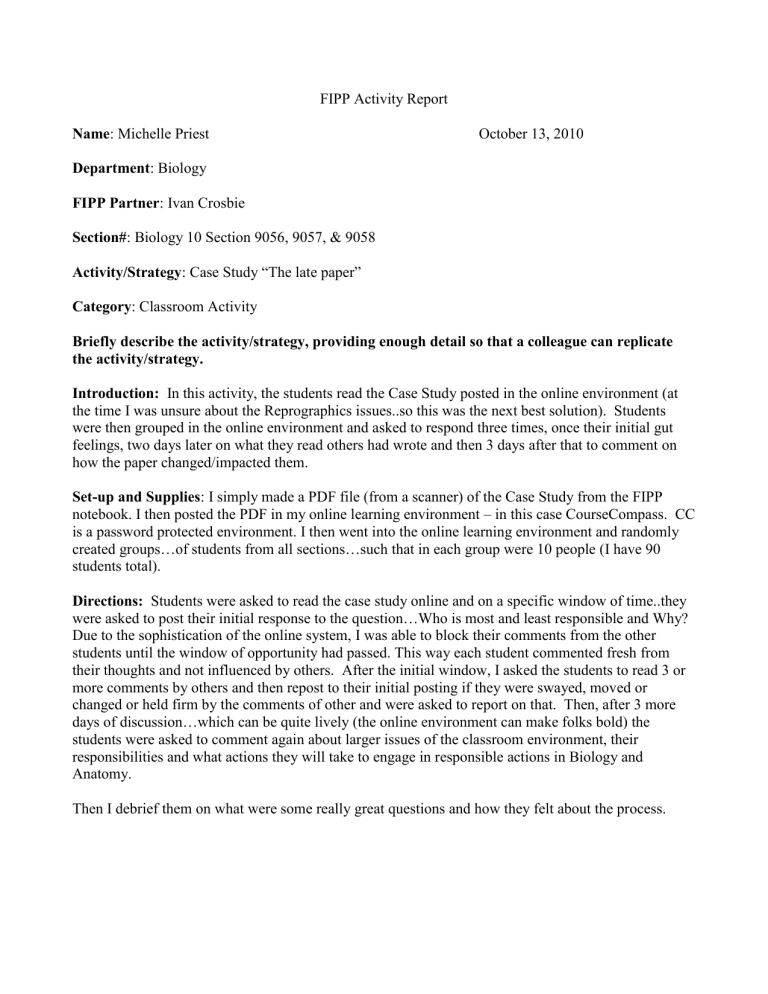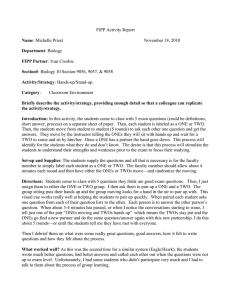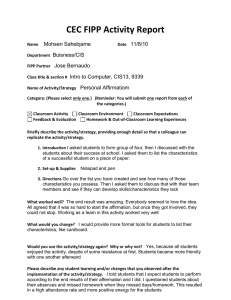FIPP Activity Report October 13, 2010 Name

FIPP Activity Report
Name : Michelle Priest
Department : Biology
FIPP Partner : Ivan Crosbie
Section# : Biology 10 Section 9056, 9057, & 9058
Activity/Strategy : Case Study “The late paper”
October 13, 2010
Category : Classroom Activity
Briefly describe the activity/strategy, providing enough detail so that a colleague can replicate the activity/strategy.
Introduction: In this activity, the students read the Case Study posted in the online environment (at the time I was unsure about the Reprographics issues..so this was the next best solution). Students were then grouped in the online environment and asked to respond three times, once their initial gut feelings, two days later on what they read others had wrote and then 3 days after that to comment on how the paper changed/impacted them.
Set-up and Supplies : I simply made a PDF file (from a scanner) of the Case Study from the FIPP notebook. I then posted the PDF in my online learning environment – in this case CourseCompass. CC is a password protected environment. I then went into the online learning environment and randomly created groups…of students from all sections…such that in each group were 10 people (I have 90 students total).
Directions: Students were asked to read the case study online and on a specific window of time..they were asked to post their initial response to the question…Who is most and least responsible and Why?
Due to the sophistication of the online system, I was able to block their comments from the other students until the window of opportunity had passed. This way each student commented fresh from their thoughts and not influenced by others. After the initial window, I asked the students to read 3 or more comments by others and then repost to their initial posting if they were swayed, moved or changed or held firm by the comments of other and were asked to report on that. Then, after 3 more days of discussion…which can be quite lively (the online environment can make folks bold) the students were asked to comment again about larger issues of the classroom environment, their responsibilities and what actions they will take to engage in responsible actions in Biology and
Anatomy.
Then I debrief them on what were some really great questions and how they felt about the process.
What worked well? Several students commented that while they had very clear thoughts on who was to blame in the paper; in their own lives they often have very different ideas of what should be done.
Many thought for others the rules are fine, but for them; understanding and bending should be done.
I found it interesting that many thought that faculty should bend the rules and understand for them but not necessarily for others. When I asked them to explain why and when the rules apply….they gave conflicting answers and students in the discussion group called them out on it and forced the conflicted student to rethink and edit their responses.
Many now understand why I hold all students accountable to the class on time rules, closed toed shoes and other rules of class. Equal application to all and clear understanding what the rules are help students to have clear expectations of themselves and their faculty member.
What would you change? I would give them shorter timelines to respond to each other and to the topic. I found that I really had to prod them in class and online to do the work…until the activity was associated with bonus points…most students weren’t interested in participating. I would make this part of the “knowing the syllabus quiz” that I put at the end of the 2 nd
week of classes.
Would I use the activity/strategy again? I definitely would. I have used it in my Biology 10 classes with the above mentioned adjustments!
Please describe any student learning and/or changes that you observed after the implementation of the activity/strategy. Many of the students in both Biology 10 and Anatomy 30 are pushing each other to follow the rules and not cutting each other any slack when they fail. Many are finding the adherence to the rules a more common expectation across campus.





